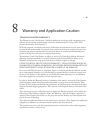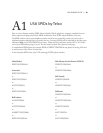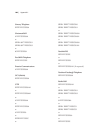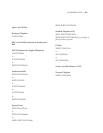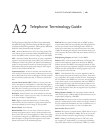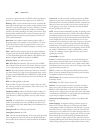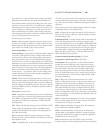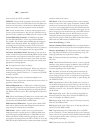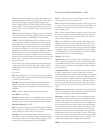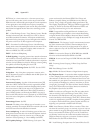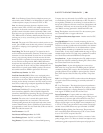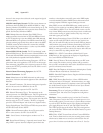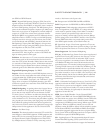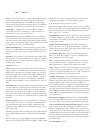GUIDE TO TELEPHONE TERMINOLOGY | 105
your station runs a contest) the other choke exchange users will be
blocked because all trunks into the choke exchange will be busy.
In the modern network, using CCIS signaling such as SS7, actual
trunks are not used to convey “busy” or “all trunks busy” conditions.
us blocking due to a station contest should not occur as the busy
status in response to a call attempt is conveyed over the separate
SS7 network. erefore, the need for choke exchanges has pretty
much disappeared. Nonetheless, many Telcos still insist that Broad-
casters use special choke lines for call-in lines.
See blocking and concentration.
Circuit- A physical path through which electrical signals can pass.
It consists of a network of conductors and other components, sepa-
rated by insulators. Technically this term cannot be applied to fiber
optic or other “non-metallic” paths. See also channel.
Circuit Switched Data- See CSD
Circuit Switching- A system where a dedicated channel is allocated
to the users of that call for the duration of that call. at channel
is allocated for the duration of the call regardless if information is
being transmitted at any given moment. Bandwidth through the
channel is fixed, at no time may this bandwidth be exceeded. If this
bandwidth is not used it is wasted. While inherently inefficient, the
dependable and reliable nature of circuit switching makes it ideally
suited to real-time voice and audio/video conferencing applications.
When over loaded Circuit Switched networks will respond “all
circuits are busy… try again later”. is is in stark contrast packet
switched networks or to systems where statistical multiplexing is
used. See Statistical Multiplexing.
CLASS- Custom Local Area Signaling Services. A variety of en-
hanced features (usually on analog lines) that take advantage of the
ability of modern SS7 technology’s ability to transmit information
about the calling party. CLASS includes such features as Caller ID,
Automatic Callback, Call Trace (initiated by subscriber), Selective
Call Screening, etc.
Clear Cause. See Cause Code
CLEC- Competitive Local Exchange Carrier. Your local telephone
service provider who is one of the new-generation providers rather
than a RBOC or Independent. A CLEC is really just an indepen-
dent, albeit one formed after the divestiture of AT&T. See LEC
and Independent.
CLI - Calling Line Identity. European term for CLID. See CLID.
CLID- Calling Line Identification. is is the ISDN and SS7
equivalent of Caller ID; I.E. the number of the calling party. See
also Caller ID and ANI.
CO- Central Office. e Telco facility to which your local tele-
phone circuit lead. Contains “Switches” and “Trunks” as well as the
local telephone circuits.
Codec- COder/DECoder. A device which takes digitized audio
and “codes” it in order to reduce the transmission bit rate and which
can also simultaneously “decode” such coded audio. Strictly speak-
ing, a codec does not include an ISDN terminal adapter and related
equipment.
Simple codecs are also used in digital telephony. ese use a simple
companding scheme to reduce channel noise.
COL - COnnected Line number. European Term. e number to
which you have connected. is may not be the number you dialed
if call forwarding is used.
Combination Trunk- A trunk (channel) which can both make and
receive calls. is generally refers to analog ground start or loop
start trunks, although the term can be applied to ISDN BRI or PRI
channels as well. Each combination trunk normally has a telephone
number, although they are frequently part of a hunt group and only
one number may be published for that group. Also called a Both
Way Trunk. is is not the same as a Two-way DID trunk. See
DID trunk, Hunt Group and Trunk.
Common Channel Interoffice Signaling- See CCIS
Competitive Local Exchange Carrier- See CLEC.
Concentration- e basic premise is to share facilities wherever
possible. For instance, while there may be thousands of custom-
ers served by a given Central Office, there will be substantially less
than that number of calls which can be handled simultaneously.
And, even fewer long distance calls can be made simultaneously.
e art of Traffic Engineering is to have enough capacity that calls
are rarely blocked, but no more than that number. See also Choke
Exchange and Blocking.
CPC- Calling Party Control. Sometimes referred to as “CPC
Wink” or “disconnect supervision”. A call supervision feature on an
analog loop start line that provides the ability for a CO (Central
Office) to signal the called party when the calling party hangs up.
CPC allows the PBX, key system, or telephone answering device
to reset the line so that it is ready to accept or initiate another call.
CPC is accomplished by either a loop current drop or reversal. With
some CO equipment, it is also provided if the called party drops the
call. See also MCLD.
CPE- Customer Premise Equipment- Customer owned equipment
located at his/her facility, such as a CSU or terminal. In the USA
and Canada, the NT1 is part of the CPE.
CPN - Called Party Number - European Term. e number that
has been dialed. See Called Party Address.
CSD- Circuit Switched Data- A dial-up data communications
channel which, once established, looks like a transparent data pipe.
Also, the type of ISDN service required to utilize this capability of
an ISDN circuit. In contrast to CSV.
CSU- Channel Service Unit. e NCTE used in the USA &
Canada to terminate a T1 line. Typically the CSU must be provided



